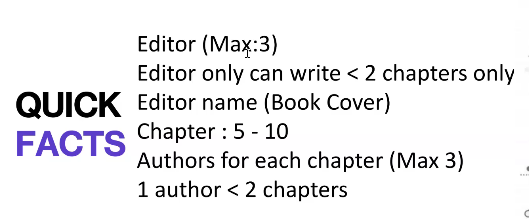Episodic episteme
Saturday, 5 April 2025
音韵人生:我与音乐的若即若离
Sunday, 4 December 2022
Managing your research
马斯克说过:
高手做管理都擅长把工作4化:
复杂的事情简单化,
简单的事情流程化,
流程化的事情标准化
标准化的事情制度化。
Complex > Simplify > Processtize > Standardize > Institutionalize
工资是发给日常工作的人: Salary is paid to people who work on daily basis;
高薪是发给承担责任的人: High salaries go to those who take responsibility
奖金是发给做出结果的人: Bonus is given to those who produce results
股权是发给能干忠诚的人: Equity is issued to capable and loyal people
荣誉是发给有理想抱负的人: Honor is given to those who have ideals and ambitions.
辞退信是送给没结果,还耍个性的人
Sunday, 21 August 2022
Indexing with Clarivate
I attended the Webinar of Former Pengarah Penerbit UTEM, Ts. Dr. Siti Nurul Mahfuzah Mohamad.
Monday, 25 July 2022
Reading "Inventology: How we dream up things that change the world" by Pagan Kennedy
2016: Boston - Houghton Mifflin Harcourt
Contents
Introduction
Part 1: Problem Finding
1: Martian Jet Lag
2: User-inventors
3: Someone else's shoes
4: The future of feedback
Part 2: Discovery
5: Super-encounters
6: Data goggles
7: Building an empire out of nothing
Part 3: Prophecy
8: The Pong effect
9: The Wayne Gretzky game
10: The mind's R&D lab
11: How to time-travel
Part 4: Connecting
12: The go-betweens
13: Zones of permission
14: Holistic invention
Part 5: Empowerment
15: Paper eyes
16: Tinkering with education
Conclusion
Thursday, 21 July 2022
FAQ for proposal defence with UCSI University
Herewith the FAQ I asked my students to prepare, which I found here at https://bemoacademicconsulting.com/blog/thesis-defense-questions
1. What is your research study all about?
2. Why did you choose this study?
3. Why did you choose this particular title for your research?
4. What is the scope of your study?
5. What phenomenon were you trying to understand with this research?
6. Who will be most interested in your research?
7. Did your research questions evolve during the process? If so, how?
8. What gaps did you intend to bridge with your research?
9. Why is your research significant?
10. Why did you choose this research methodology?
11. What sources did you plan for data collection?
12. How can your research be put into practice?
13. How will your findings contribute to the related area of knowledge?
14. What sampling techniques do you plan to use?
15. What instruments do you plan to use to collect data?
Wednesday, 29 June 2022
How to achieve what you want? By Dr Shane Murphy
Tuesday, 17 May 2022
Bengkel Penerbitan dan Penulisan Artikel Systematic Literature Review
I am attending a workshop conducted by Dr Wan Azani Wan Mustafa.
He wrote 60 articles in 1 year for the past 4 years (H-Index 15).
We should write for WoS articles with impact factors (Q1 and Q2), "Kita yang macam2-kan sendiri, target yang paling tinggi."
There is no method or results in SLR paper.
Research article: methods & results.
SLR can be done in a room, no need to collect data.
Every scholar in Malaysia must own 3 accounts: Google Scholar, SCOPUS ID, Publons Web of Science ResearcherID
Purpose of academic writing: KPIs, reward, satisfaction
If your research is not published in a journal, it does not exist.
Mitos:
1. Artikel panjang tak semestinya accept. Tak tengok panjang pendek.
Mistake:
Do not wait! Target 1000, can start to write when you have around 300 (as the first paper); 700 (can be another paper); 1000 (3rd paper).
研究员(包括我)经常犯的错误,就是等到数据收集完结后才做分析,才发文章。整个数据收集过程可以分成最少三次发文章的机会:早期(pilot study paper)、中期(interim analysis paper)和后期(research paper)。如果想收集的数据总量是1000人,早期分析(100人)、中期分析(500人)和后期分析(1000人)都可以发一篇文章。
Every June, Institute of Scientific Information (ISI) will release a report on citation indexed.
Netherland: SCOPUS = 21 areas (40,000 journals)
US: Web of Science = 15,000 journals in SCOPUS
Q in SCOPUS is not same Q in ISI
Quartile is based on impact factor, i.e. no impact factor, no Q.
Q1 or Q2 in Web of Science ISI are the highest in the world.
SCOPUS adalah badan indexing. 21 criteria must be fulfilled to be indexed by SCOPUS.
SCOPUS keluarkan listing 3 kali setahun, boleh download di website SCOPUS. March
Must check with SCOPUS listing before submission.
SCOPUS
- Life sciences
- Health
- Physical science
- Social science
Not all WoS are ISI
Bukan semua WoS ada impact factor:
- Only SCI expanded and SSCI are indexed with impact factor.
Comments paper = 2 pages
40 - 50 references for Research Article
Review article
Comprehensive / critical review on specific research topic
Typically 15+ pages (not more than 20 pages), 5+ figures (copy from reviewed papers with full citation), table of summary and 70 - 200 references.
Tak baca, tak download pun.
Structure of a manuscript for Review Article
- Title
- Affiliation
- Abstract
- Keywords
- 1. Introduction / Literature review
- 2. Conclusion/s
- Acknowledgements
- References






